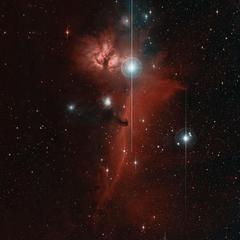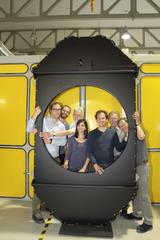URL: https://www.desy.de/news/news_search/index_eng.html
Breadcrumb Navigation
DESY News: New camera scans the heavens for exploding stars
News
News from the DESY research centre
New camera scans the heavens for exploding stars
A new robotic camera will scan the sky every night to discover exploding stars, matter devouring black holes and other short-lived, violent phenomena in the cosmos. The Zwicky Transient Facility (ZTF) has the ability to capture hundreds of thousands of stars and galaxies in a single shot and can survey the night sky particularly fast. The U.S. based facility led by the California Institute of Technology (Caltech) has various international partners, among them DESY and Humboldt University from Germany. The ZTF has taken its first image of the sky, an event astronomers refer to as "first light." It shows a part of the constellation Orion on the northern sky, featuring a turbulent star forming region with the famous horsehead nebula in it.

ZTF took its first light image on 1 November 2017. The segment shown here features the emission nebula IC 434 in the constellation Orion, including the famous horsehead nebula B 33 in the centre of the image and the flame nebula NGC 2024 just above IC 434. Computers analysing these images for transient events are trained to ignore non-astronomical features like the vertical lines shown here. Credit: Caltech Optical Observatories
ZTF is based at Caltech's Palomar Observatory located in the mountains near San Diego. The name Zwicky refers to the first astrophysicist at Caltech, Fritz Zwicky, who arrived at the university in 1925 and who would go on to discover 120 supernovas over his lifetime. ZTF's new state-of-the-art survey camera was recently installed at the Samuel Oschin Telescope, a Schmidt type reflector telescope with a particularly large field of view. The camera can see 47 square degrees of sky at a time, or the equivalent sky area of 247 full moons. Thanks to this large field of view and fast telescope-drive systems, ZTF can scan the entire sky over three nights and the visible plane of the galaxy twice every night.
“Each image the camera takes is more than 24,000 by 24,000 pixels,” says Richard Dekany, the project manager for ZTF at Caltech. The images are so huge that it would take 72 ultra-high-definition monitors to display them at full resolution. Design and construction of the facility was a technological challenge, especially as the camera had to fit into the comparatively small telescope tube. To make this possible, new solutions for technical requirements had to be developed. For instance, the camera's shutter that is usually mounted right in front of it, was moved to the outside the whole telescope and had to be built exceptionally big. “With a diameter of 1.3 metres, we have constructed the largest shutter ever built for astronomy,” explains Marek Kowalski, Leading Scientist at DESY and Professor for Astroparticle Physics and Cosmology at Humboldt University in Berlin.

The ZTF camera features the largest shutter ever built for an astronomical instrument. With a diameter of 1.31 metres, it was constructed and tested at DESY together with the Bonn Shutter Groupp. Credit: DESY
“I'm really curious to see the first ZTF observations of the fast fading blue flashes from merging neutron stars or the longer lasting flares from supernova explosions of massive stars,” says Kowalski. “Catching such cosmic fireworks enables a new era of multi-messenger astronomy by studying astronomical objects with light, gravitational waves and neutrinos.” ZTF's science survey phase is scheduled to begin in February of 2018.
About half of ZTF is funded by the National Science Foundation of the US. The rest comes from its partners, including the Weizmann Institute for Science, the Oskar Klein Center at Stockholm University, the University of Maryland at College Park, the University of Washington, DESY, Humboldt University, Los Alamos National Laboratory, the TANGO Consortium of Taiwan, the University of Wisconsin at Milwaukee, and Lawrence Berkeley National Laboratory.
Zwicky Transient Facility Website:
https://www.ptf.caltech.edu/ztf
Caltech ZTF video:
https://www.youtube.com/watch?v=aVhMVwwUwUE



